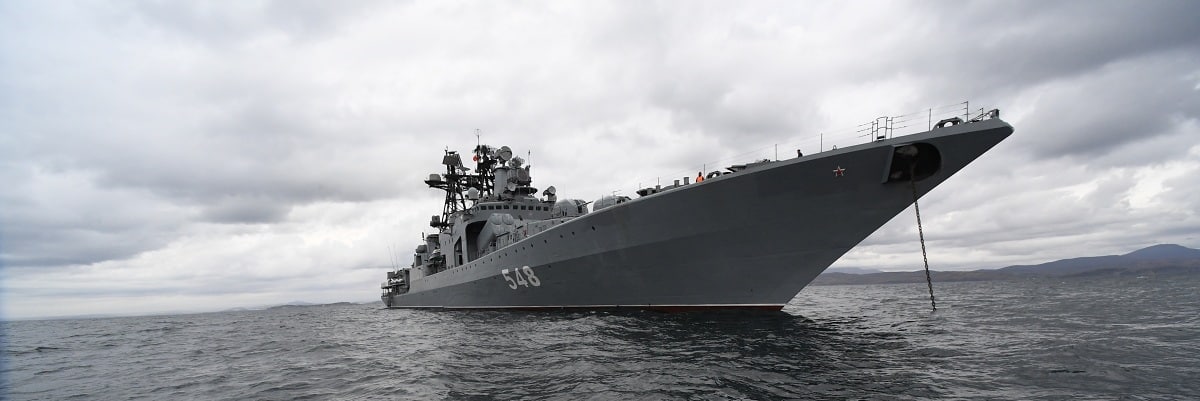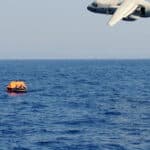Russian naval forces
More than 45 warships of the Black Sea Fleet and other Russian fleets are now present in the Sevastopol and Novorossiysk bases. The commander of the Black Sea Fleet is Kazakh-born Admiral Igor Osipov, supervisor of attack strategies from the sea, also included in the list of sanctioned by the EU.
The Russian "special operation" involves frigates, corvettes, missile ships, landing ships, destroyers, submarines and countermeasures ships. Naval formations, landing units - the equivalent to our navy infantry - and naval aviation carry out artillery actions, missile attacks and bomb drops on maritime and coastal targets. In addition to attacks on disputed territory, another Russian objective is the defense against possible Ukrainian counterattacks of the Crimean coast, bases and ports in Russian territory, and various sensitive infrastructure and areas of maritime economic activity.
On March 24, three Russian landing ships were struck in the port of Berdyansk, 80 kilometers southwest of Mariupol on the Azov Sea. One sank in front of the pier; two made it to sea despite damage on board. The Ukrainians are believed to have used one or more "Tohcka" short-range tactical ballistic missiles with a range of about 200 kilometers. The sunken ship is the Saratov. It is speculated that it was delivering ammunition for the column of naval infantrymen landed in the same port a few days ago. The Kunikov left the port with a large fire in the bow. It is a unit of the "Ropucha" class; it can land 10 tanks and 340 marines on the beach. The third would be the Novocherkassk (of the same class), which showed smoke coming from the lower decks. Berdyansk was Kiev's main military facility in the Sea of Azov, now occupied by the Russians.
Finally, it must be remembered that in the Mediterranean two naval groups operate, one of 4 units and the other of 6, referring respectively to the ports of Tobruk and Benghazi (Libya) and those of Tartus and Latakia (Syria).

Black Sea and Azov Sea
Ukrainian naval forces
Established in 1992 after the mutiny of the patrol vessel SKR-112 which raised the yellow-blue flag on the shore, the Ukrainian Navy was composed of 11 warships ( obsolete corvettes, patrol vessels and minesweepers), 10 aircrafts (including some deadly Turkish drones "Baykar TB 2"), about twenty logistic ships. After the Russian invasion of Crimea the fleet moved to Odessa. With the outbreak of war, the ships remained idle in port, and the flagship Hetman Sahaidachny (a former Russian frigate class "Krivak III"), already under repair in Mykolaiv shipyards, was voluntarily flooded by the commander to avoid falling into the hands of the enemy.
The strategic importance of the Black Sea
As detailed elsewhere, the real cause of the conflict appears to be the Russian will to completely control the Sea of Azov and the northern coast of the Black Sea. With Turkey, Bulgaria and Romania - belonging to NATO - overlooking the Black Sea together with Russia, Ukraine and Georgia, it is easy to understand how that sea can only be the object of potential dangerous disputes between Russia and NATO itself.
The manoeuvres in the field should be read according to this perspective: for Russia the Black Sea is indispensable because it is the obliged passage not only towards the Mediterranean, but also towards the Atlantic and the Indo-Pacific. It is through the Black Sea that Moscow can reach strategic maritime lines of communication that would otherwise be - de facto - precluded. The traffic of ships in those straits is 55 thousand units per year, four times more than the Suez and Panama canals. The Bosphorus is the main route for the transport of oil from the Caucasus to the countries of Europe and Asia. Sixty-five percent of Russian exports pass through the Bosphorus and, in addition to oil, wheat also passes through, which from the markets of Russia, Ukraine and Kazakhstan covers 25% of the world's needs. Moreover, cast iron and semi-finished steel products pass through the Black Sea for 10% of European needs and Italy is currently suffering from a shortage.
Strategically speaking, it is more important for Russia to own the Odessa naval base, Mariupol and coastal shipyards such as Mykolaiv than Kiev.
The strategic importance of the Azov Sea
The annexation of Crimea and now of the entire Sea of Azov (historically considered by the Russians as an internal bay of their territory, where consequently the international maritime law is not applicable) and of its coastal cities is part of a clear strategic project of Putin's Russia. A project that, through the Black Sea and Syria, reaches the Mediterranean.
The Azov Sea represents the submerged delta of the Don River, which flows into it together with the Kuban River. It is a crucial point of outlet for commercial and military transport of Russia: through the Lenin-Volga-Don waterway it is possible to access the Caspian Sea and connecting with the waterways of European Russia, which allow to navigate to Moscow, the Baltic Sea and the White Sea. Russia therefore ceases to be a tenant in Ukraine and becomes the owner of important shipyards and naval bases on the coast.
As for the Kerch Strait, it must be underlined that it represents a real choke point (like Panama, Suez, Dardanelles and Hormuz), such as of vital importance for Russia: it connects its endless hinterland to the Black Sea. The Strait and the Sea of Azov were open issues in Russian-Ukrainian relations, such as the two countries already in 1995 had started negotiations that were never actually concluded.
Given the current regime of occupation of Ukrainian port cities, the Sea of Azov is in any case inaccessible to foreign traffic because it is under complete Russian control.
How will the war end?
It is difficult to envisage peace in those tortured lands, if not when Russia will have achieved the objectives it considers vital: to settle permanently in the Donbass, to have the coasts of the Sea of Azov completely in its hands. Including the main cities such as Melitopol, Berdiansk, Mariupol. The Russian appetites could extend towards Odessa (that I believe will remain Ukrainian), with the control of the main ports and shipyards of the coast in the oblasts of Mykolaiv, Kherson, Zaporizija, Kryvij. In the north, the conquest could concern the Sumy and Kharkiv oblasts.
In essence, a new geographic and political reality east of the Dnieper River, separated from the part to the west that would remain under the control of Kiev.
Senior Fellow of the Centro Studi Machiavelli. Admiral of division (res.), former commander of destroyers and frigates, he has held important diplomatic, financial, technical and strategic assignments for the Defence and Navy Chiefs of Staff, both at home and abroad, at sea and on land, pursuing the application of capabilities aimed at making the Italian defence and security policy effective.









Scrivi un commento